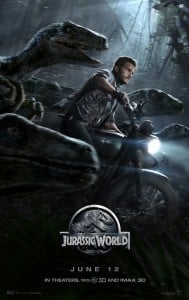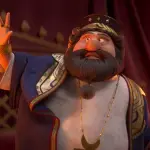[This is an expanded, revised version of a review originally published at Christianity Today Movies.]

–
What would we do without “Once upon a time…”?
For most of us, that famous opening line conjures vivid memories of children’s stories about knights, magic spells, wicked witches, dragons, epic battles, and curses broken by the power of a kiss. But many grownups have folded up their imaginations and stuffed them in a closet, pooh-poohing stories about princesses and goblins.* It’s tough to maintain an appreciation for childlike whimsy and make-believe.
Lately, thanks to the success of Peter Jackson’s The Lord of the Rings films and the publishing phenomenon of J.K. Rowling’s Harry Potter, many adults have “come out of the closet” as fantasy enthusiasts. And as a result, more and more authors and artists are creating fantasies specifically crafted for adult imaginations.
When it comes to “adult fairy tales,” author Neil Gaiman is one our most popular tale-spinners. The man who imagined Sandman, Neverwhere, American Gods, Coraline, and the movie Mirrormask has roots deeply planted in traditional fairy tales from Andersen to Grimm. In novels, graphic novels, and comic books, he fuses differing cultural mythologies into striking new visions that convey spiritual ideas.
Stardust, directed by Matthew Vaughn (Layer Cake) is the latest Gaiman yarn to be tailored for the big screen. Its big-name cast will surely draw a crowd of adults to the theater, but its PG-13 rating and fairy-tale style will attract a younger crowd as well.
And that‚Äôs a big problem. Parents should be warned that if young viewers run from the movie to the novel, they’ll be exposed to scenes of gratuitous sex and material inappropriate for younger readers. So be warned: If your kids like this PG-13-rated movie, it may lead them to an R-rated book.
As this is a review of the movie, not the book, let’s focus on what moviegoers will encounter:
The title — Stardust — refers to the magical aura of the story’s celestial damsel in distress. Yvaine (Claire Danes) is a star. Seriously. And she’s lived in a heavenly realm for many years. When the king of Stormhold (Peter O’Toole) brings her crashing down to earth, she finds herself and her magical ruby hunted by dangerous agents. Evil princes want to claim the ruby and thus the kingship. A particularly wicked old witch (Michelle Pfeiffer) wants to cut out Yvaine’s heart to steal its power, regaining physical beauty and youth. A garrulous trader (Ricky Gervais) wants, well, money. And a gallery of ghosts straight out of Beetlejuice play a not-so-Greek chorus to the developing chaos.
But thanks to the power of a transportation device called a “Babylon candle,” someone else finds Yvaine first. Young Tristan Thorne (Charlie Cox) is trying to prove his love to Victoria (Sienna Miller), the self-absorbed beauty who has claimed his heart. He promises Victoria that he’ll fetch her that fallen star, and he crosses over a magical boundary from the quaint village of Wall into the realm of Stormhold. When Tristan discovers Yvaine, he puts her on a leash and drags her along in what becomes the most elaborate cross-country chase since Midnight Run.
Tristan thinks his discovery will win Victoria’s heart. But every moment with the fallen star takes him into a deeper understanding of love, and before it’s over, he’ll solve some of the mysteries of his parentage. Meanwhile, Yvaine will find the missing piece of the heart she seeks to protect.
Narrated by Gandalf himself (Ian McKellan), Gaiman’s fantasy is wild, fast-paced, unpredictable, and packed with references to other tales. Like many contemporary fantasies, the story’s themes could be easily reduced to bland slogans that appeal to our self-interest: “Be what you were born to be.” “Don’t conform to your society or live within its boundaries.” The sexually ambiguous airship-pirate Captain Shakespeare (Robert De Niro) serves to deliver an obvious, unfortunate message: That you should do whatever you want no matter what other people think.
But Stardust also inclines us toward more honorable insights:
- True love is based on honesty and trust rather than skin-deep lust.
- Those who cling to youth and vanity through cruel and unusual practices will end up empty and corrupt.
- The pursuit of power leads to heartlessness and destruction.
- We’re all longing to return to a higher existence, where we truly belong.
- Love opens us to a power greater than any witches’ spell.
These themes are awkwardly juxtaposed in a film that cannot decide whether it wants to be a quirky, comical tale a la The Princess Bride; an action-adventure along the lines of Willow; a dark, mystical fantasy like Ridley Scott’s Legend; or clash of CGI-powered wizards straight out of Harry Potter; or a costume party for legendary actors.
Stardust’s extravagant design is its greatest strength. Loosely based on Charles Vess’s illustrations for Gaiman’s original graphic novel, the movie is full of castles, inns, mansions, and enchanting fantasy landscapes provided by Iceland and Scotland. These are cleverly sewn together with digitally animated environments in ways that reflect the influence of Jackson’s Middle Earth and Andrew Adamson’s Narnia.
Lucinda Syson has assembled a remarkable cast who keep us engaged with enthusiastic performances. The radiant Claire Danes gives it her all, as usual, conjuring a convincing British accent. Charlie Cox is charming, growing Tristan up into a winsome swashbuckler. And Peter O’Toole, in his brief appearance, conveys more intelligence and power than any of the other big names.
But the movie belongs to Michelle Pfeiffer. In a welcome return to fairyland, Pfeiffer reminds us that she is still one of the big screen’s most enchanting beauties. She hasn’t lost the spark that made her such a luminous presence in Ladyhawke twenty-two years ago. It’s too bad that her best moments are quickly shoved aside so she can become a canvas for makeup artists. (When one spell begins to lose its, um, “holding power,” her breasts suddenly sag.) Pfeiffer’s bold, self-effacing performance makes us wish for a role that takes full advantage of her talents, and her beauty, soon.
Robert De Niro turns in one of his wackiest performances as the gruff Captain Shakespeare, a zeppelin-piloting pirate who keeps a particularly un-pirate-like secret in his closet. But while he wins a lot of laughs, his performance breaks the movie’s spell. We’re laughing because, well, it’s Robert De Niro dancing around in a petticoat. A lesser-known actor could have made the flamboyant captain a stronger character, and avoided the distraction of “stunt casting.”
While he’s clearly working with combustible talents, Vaughn seems incapable of mustering any sense of mystery, magic, suspense, or grace here. His experience working with director Guy Ritchie (Lock, Stock and Two Smoking Barrels) shows — the film’s far too heavy-handed and action-oriented to cast any kind of lasting spell.
Fantasy is a tricky thing. A little bit of magic goes a long way, and too much of it can spoil any sense of suspense. In Richard Donner’s Ladyhawke, a powerful love story grew around one simple curse, and we were led through the story by an unforgettably quirky and endearing narrator. In Stardust, there are so many powers, talismans, spells, and transformations that it becomes distracting and confusing. The movie is so busy explaining its hodge-podge hocus-pocus that it fails to develop strong characters. (And why do these powerful witches, capable of unleashing spectacular magical assaults against their enemies, have so much trouble performing a simple age-reversal ritual once the tools are within their grasp?)
All of this goes to remind us that The Princess Bride really is a treasure. Balancing wit and wisdom with a self-effacing wink, Rob Reiner’s timeless fantasy classic is an acrobatic masterpiece. It played to the strengths of its actors, while Stardust wants us to laugh at how De Niro and Pfeiffer play against type. The Princess Bride had a feeling of spontaneity; the comedy in Stardust feels forced. The Princess Bride never needed to jolt us or jar us to hold our attention; but the closer we get to the end of Stardust, the more it devolves into a marathon of furious special flourishes.
Still, the power of fairy tales to illuminate transcendent mysteries does glimmer along the feeble threads of this story. It’s enough to whet our appetites for bigger (and hopefully better) fairy tales scheduled for release in the next few months. The Seeker: The Dark is Rising is based on strong source material, but the preview is packed with clichés. The Golden Compass looks like a million bucks, but its author has spoken forcefully about how the story was written to lure young readers away from the Christian ideas manifested in The Chronicles of Narnia.
“Once upon a time,” George Macdonald, C.S. Lewis, J.R.R. Tolkien, and Madeleine L’Engle crafted fantasy adventures that resonated with redemptive power. Will any of these upcoming features surprise us with meaningful storytelling? Who will be the storytellers capable or rekindling such cosmic imagination?











